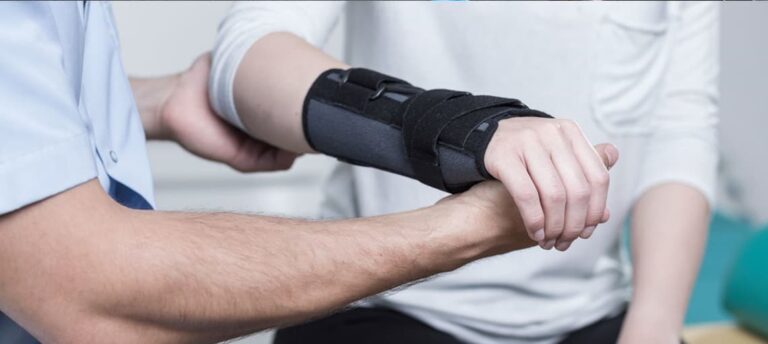If we talk about the shoulder joint, it is one of the most complicated structures and most likely joint to dislocate. For instance, a dislocated shoulder happens when the upper arm ball “the humerus” slips out of the shoulder’s socket “glenoid labrum”.
A shoulder dislocation is associated with unbearable pain and inability to move the arm around until it gets fixed back into the socket.
A partial shoulder dislocation is known as “Shoulder Subluxation” in which the shoulder’s joint comes partway out prior relocating.
This post will discuss various techniques of physiotherapy for dislocated shoulder. But first, let’s discuss what causes dislocated shoulder?
Causes of a Dislocated Shoulder
 physiotherapy for dislocated shoulder | Source: pexels.com
physiotherapy for dislocated shoulder | Source: pexels.com
A shoulder is one of the most mobile joint in the human body, and offers an expansive range of motion. It helps you to lift your arms out to the sides, overhead, rotate behind head and back, etc. However, this incredible range of motion means a lot of stability.
Subluxation or shoulder dislocation can occurs from underlying shoulder joint instability or sudden trauma. There are many causes of a dislocated shoulder, and the commons ones include:
Traumatic Shoulder Dislocation
Traumatic shoulder dislocation is the most common cause. It happens when the shoulder is in an unsafe position and pushed out quickly. This kind of injury is common one during a fall or in a football tackle.
Multi-Directional Instability
In very few patients, your shoulder because of the genetic disposition is unstable in several directions. In this case, the shoulder may feel dislocated or loose in multiple directions. This situation is known as “multi-directional instability.”
Repetitive Shoulder Ligament Overstrain
Sometimes, the loose ligaments in the shoulder can easily dislocate it. The most common cause of it is repetitive over-stretching of your shoulder joint. In some sports, such as cricket, baseball, swimming, volleyball, etc. repetitive overhead motion is required, which can overstretch the shoulder joint capsule and ligaments. Looser ligaments make it difficult for rotators cuff muscles to maintain the shoulder’s stability. If you’ve an unstable shoulder, you can prevent or rehabilitate the shoulder dislocation by undertaking a shoulder rotator cuff strengthen program.
So, what are the symptoms of a dislocated shoulder?
Symptoms of a Dislocated Shoulder
Some common symptoms of a dislocated shoulder include:
- Extreme pain in your shoulder.
- Repetitive instances of your shoulder giving out.
- Arm weakness or pins/needles numbness.
- Apprehension to place the shoulder in certain positions.
Physiotherapy for a Dislocated Shoulder
 Source: pexels.com
Source: pexels.com
Once your dislocated shoulder has been moved back into its position, your physiotherapist will place a sling with your arm to make your shoulder comfortable and prevent re-injury. The physiotherapist will also examine your health and history of the injury to determine your rehabilitation requirements.
Depending on the examination results and your health, the physiotherapist will then guide take you through a rehabilitation program to restore strength, mobility, and joint awareness.
Physiotherapy for dislocated shoulder may include the following points:
Range of Motion Exercises
Pain and swelling will reduce the shoulder movement. The physiotherapist will guide you what exercises are effective and safe that you can perform to restore your shoulder’s full range of motion. The physio may also use hands-on therapy technique to decrease pain in your shoulder.
Exercises for Strength
Weak muscles are more prone to re-injury and can cause shoulder joint to stay unstable. Depending on the severity of your injury and where you’re on the path to rehabilitation, your physio may suggest you some exercises that are effective to restore your shoulder’s strength and rehabilitation.
Muscle Training and Joint Awareness
Performing specialized exercises are incredibly helpful to your shoulder muscles and enable them to respond sudden forces. Your physio may prepare a list of individual exercises that are helpful for you to perform regular activities.
Sport-Specific Training
Based on the requirements of the sport you play or your job, it would be great to take additional rehabilitation tailored to the requirements of your shoulder activities into account. Your physiotherapist will create a program to full-fill all these demands. For instance, if you’re a baseball pitches (overhead thrower), your physio will teach you via throwing progression and pay close attention to your specific throwing mechanics.
How Long Will Physiotherapy for Dislocated Shoulder Take?
Since every injury is different and everyone’s healing rates are different, most people need several weeks to return back to normal after a shoulder dislocation injury. If the shoulder dislocation injury is very severe and requires a surgery, it will take far longer than weeks.
However, you should trust that your physiotherapist and surgeon will work as a team to ensure the therapy you perform is effective and will get you back to normal.
Wrapping Up
That’s all about physiotherapy for dislocated shoulder. It is a painful injury and limits your ability to move your arms and perform daily life activities. If you are suffering from a shoulder dislocation, you should work with your physiotherapist so you can come back to normal and safe as soon as possible.
FAQs
Q: How long will it take to back to normal after a shoulder dislocation?
Ans: Everyone’s healing rate is different. If your injury is severe, it might take several weeks until you get back to normal. However, I suggest you should consult with your physio who will perform different physiotherapy techniques to bring you back to normal as soon as possible.





